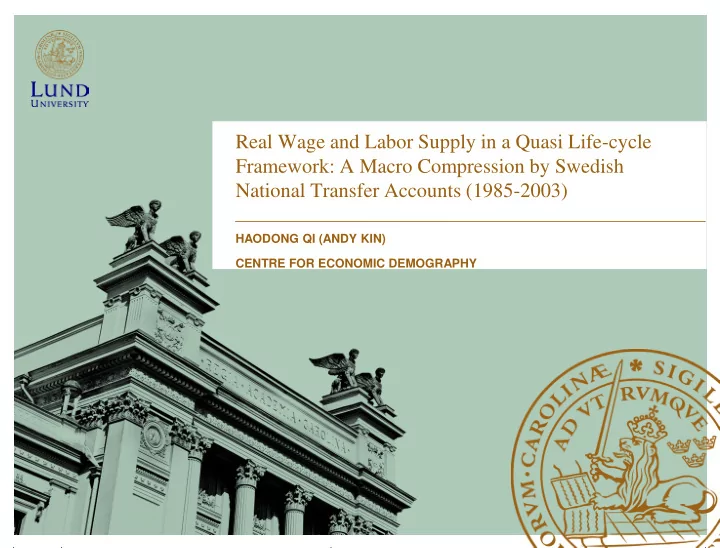

Real Wage and Labor Supply in a Quasi Life-cycle Framework: A Macro Compression by Swedish National Transfer Accounts (1985-2003) HAODONG QI (ANDY KIN) CENTRE FOR ECONOMIC DEMOGRAPHY
Background • Population ageing • Challenge: the growing per worker cost of providing a given age-vector of per capita benefits (Lee and Edwards, 2001) • One of the Solutions: Increase Labor Supply
Some OECD Stats For Sweden 2000-11 • Continous Decline in Youth LFP • 65+ remain constantly at 10%
Scientific Background • Constant Elasticity of Substitution in Overlapping Generation Model • Little consensus on estimated elasticity • The equivalence: Estimated and calibrated parameters • A vector of life-cycle parameter
Research Questions • How have age-profiles of real wage and labor supply evolved overtime? • How does the labor supply response to real wage vary over the life-cycle?
Theory predictions on wage differentials over age • Efficiency wage hypothesis (Yellen, 1984) • The shirking model (Calvo, 1979) -> Wage-productivity discrepancy • Uneven pay schedule between the young and old workers w.r.t productivity (Skirbekk, 2003). • Such pay schedual is pareto efficient w/h mandatory retirement (Lazear, 1981) • More time for senior to bid up wage (Harris and Bengt, 1982) • Union attach great weight on old workers (Pissarides, 1989)
Theory predictions on Labor supply w.r.t wage • Static Model • Individual Labor Supply Curve • Inter-temporal Substitution Hypothesis
A life-cycle labor supply function • Max U in the form of s.t.
A life-cycle labor supply function • After ..., we get, • Assuming α =1, we get,
Hypothesis
Data • Labor Income (YL) from National Transfer Accounts Sweden 1985-2003 • LFP and Employment Rate from SCB • 𝑥𝑥𝑥𝑥 = 𝑍𝑍 /( 𝑍𝑀𝑀 × 𝐹𝐹𝑀𝑍 ) • Age groups: 16-19, 20-24, 25-34, 35-44, 45-54, 55-59, and 60-64
Method • Lee-carter model: Describe the changing age profiles overtime • Age-specific time series analysis: examine differences in labor supply responses to wage over life-cycle
Results: Changing age profiles
Result: Elasticity of labor supply w.r.t wage
Result: Elasticity of labor supply w.r.t wage
Conclusion • Youth labor supply: ISH dominates • Old age labor supply: intra-temporal and income effect dominate • Reconsidering the pay schedule w.r.t. labor supply, is it optimal? • Policy implication: reforms of tax, social security as well as union policy should target on adjusting the pay schedule, i.e. increase net income for the young, lower it for the old • Scientific implication: the array of life-cycle parameters is needed for OLG modeling
Recommend
More recommend